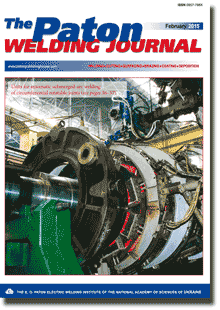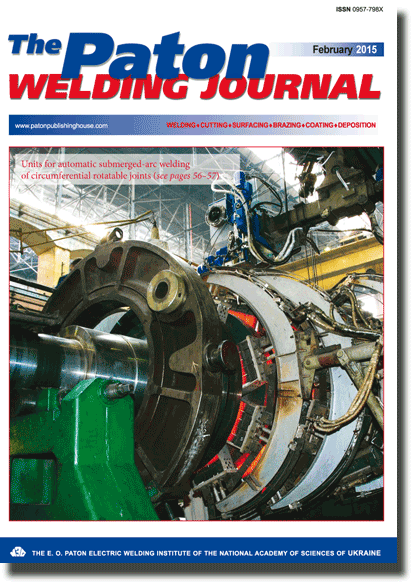| 2015 №02 (04) |
DOI of Article 10.15407/tpwj2015.02.05 |
2015 №02 (06) |

The Paton Welding Journal, 2015, #2, 26-29 pages
FEATURES OF CHROMIUM FILLER MELTING DEPENDING ON LASER RADIATION PULSE SHAPE IN WELDING AND SURFACING PROCESSES
G.A. Baevich, V.N. Myshkovets And A.V. Maksimenko
Gomel Fr. Skorina State University. 104 Sovetskaya Str., 246019, Gomel, Belarus. E-mail: rector@gsu.by
Abstract
Laser technologies are becoming ever wider applied in modern industry in welding and surfacing of metals. Here control of filler material heating and melting, its transfer and formation on the item is important. Laser radiation shapes for filler material melting and transfer with its minimum evaporation have been established with application of mathematical modeling of thermal processes. Pulse front parameters are determined, which ensure minimum energy consumption for heating and melting of chromium filler. Obtained results can be used in development of procedures of pulsed laser welding and surfacing of metals and alloys. 8 Ref., 1 Table, 9 Figures.
Keywords: laser surfacing, pulse shape, power density, pulse duration, filler material, chromium, thermodeformational melting, solidification, weld pool, energy consumption, temperature fields
Received: 23.12.14
Published: 01.04.15
References
1. Jeric, A., Grabec, I., Govekar, E. (2009) Laser droplet welding of zinc coated steel sheets. Sci. and Technol. of Welding and Joining, 14(4), 362-368. https://doi.org/10.1179/136217109X427502
2. Kayukov, S.V. (2000) Enhancement of pulsed YAG-lasers of millisecond duration range in welding technology. Kvant. Elektronika, 30(11), 941-948. https://doi.org/10.1070/QE2000v030n11ABEH001825
3. Grigoriants, A.G., Shiganov, I.N., Misyurov, A.I. (2006) Technological processes of laser treatment. Moscow: N.E. Bauman MGTU.
4. Tseng, W.C., Aoh, J.N. (2013) Simulation study on laser cladding on preplaced powder layer with a tailored laser heat source. Opt. and Laser Technol., 48, 141-152. https://doi.org/10.1016/j.optlastec.2012.09.014
5. Myshkovets, V.N., Maksimenko, A.V., Baevich, G.A. (2012) Modeling of pulsed laser welding process of thin-wall structures of aluminium alloys. Materialy. Tekhnologii. Instrumenty, 3, 16-20.
6. Farnia, A., Ghainia, F.M., Sabbaghzadeh, J. (2013) Effects of pulse duration and overlapping factor on melting ratio in preplaced pulsed Nd:YAG laser cladding. Opt. and Lasers in Eng., 51, 69-76. https://doi.org/10.1016/j.optlaseng.2012.07.015
7. Mumtaz, K.A., Hopkinson, N. (2010) Selective laser melting of thin wall parts using pulse shaping. J. Mater. Proc. Technol., 210, 279-287. https://doi.org/10.1016/j.jmatprotec.2009.09.011
8. Zinoviev, V.E. (1989) Thermophysical properties of metals at high temperatures: Refer. book. Moscow: Metallurgiya.
Suggested Citation
G.A. Baevich, V.N. Myshkovets And A.V. Maksimenko (2015) Features of chromium filler melting depending on laser radiation pulse shape in welding and surfacing processes. The Paton Welding J., 02, 26-29.The cost of subscription/purchase order journals or individual articles
| Journal/Currency | Annual Set | 1 issue printed |
1 issue |
one article |
| TPWJ/USD | 384 $ | 32 $ | 26 $ | 13 $ |
| TPWJ/EUR | 348 € | 29 € | 24 € | 12 € |
| TPWJ/UAH | 7200 UAH | 600 UAH | 600 UAH | 280 UAH |
| AS/UAH | 1800 UAH | 300 UAH | 300 UAH | 150 UAH |
| AS/USD | 192 $ | 32 $ | 26 $ | 13 $ |
| AS/EUR | 180 € | 30 € | 25 € | 12 € |
| SEM/UAH | 1200 UAH | 300 UAH | 300 UAH | 150 UAH |
| SEM/USD | 128 $ | 32 $ | 26 $ | 13 $ |
| SEM/EUR | 120 € | 30 € | 25 € | 12 € |
| TDNK/UAH | 1200 UAH | 300 UAH | 300 UAH | 150 UAH |
| TDNK/USD | 128 $ | 32 $ | 26 $ | 13 $ |
| TDNK/EUR | 120 € | 30 € | 25 € | 15 € |
AS = «Automatic Welding» - 6 issues per year;
TPWJ = «PATON WELDING JOURNAL» - 12 issues per year;
SEM = «Electrometallurgy Today» - 4 issues per year;
TDNK = «Technical Diagnostics and Non-Destructive Testing» - 4 issues per year.


